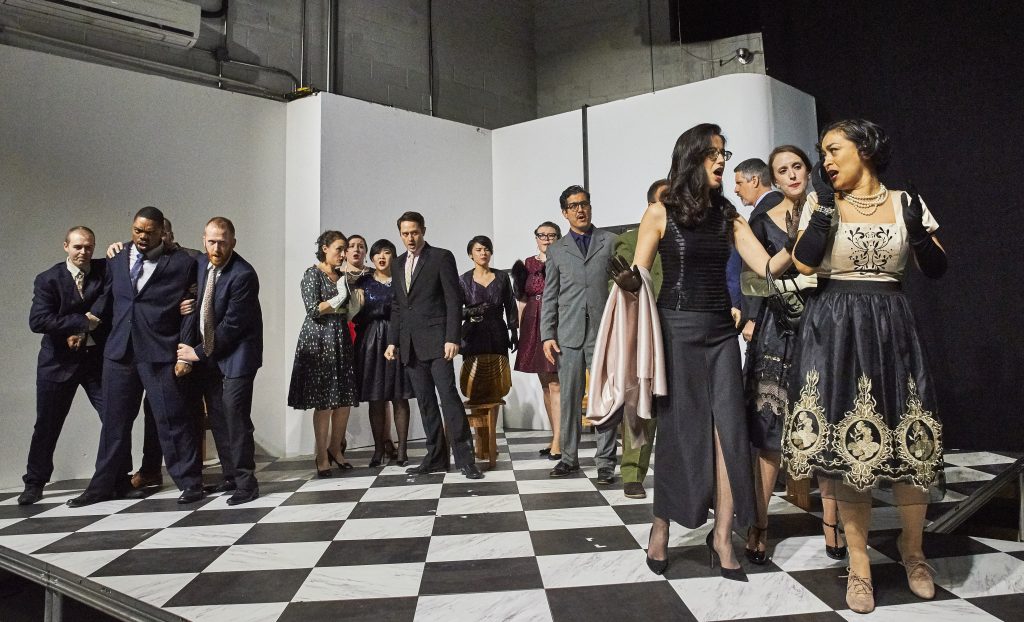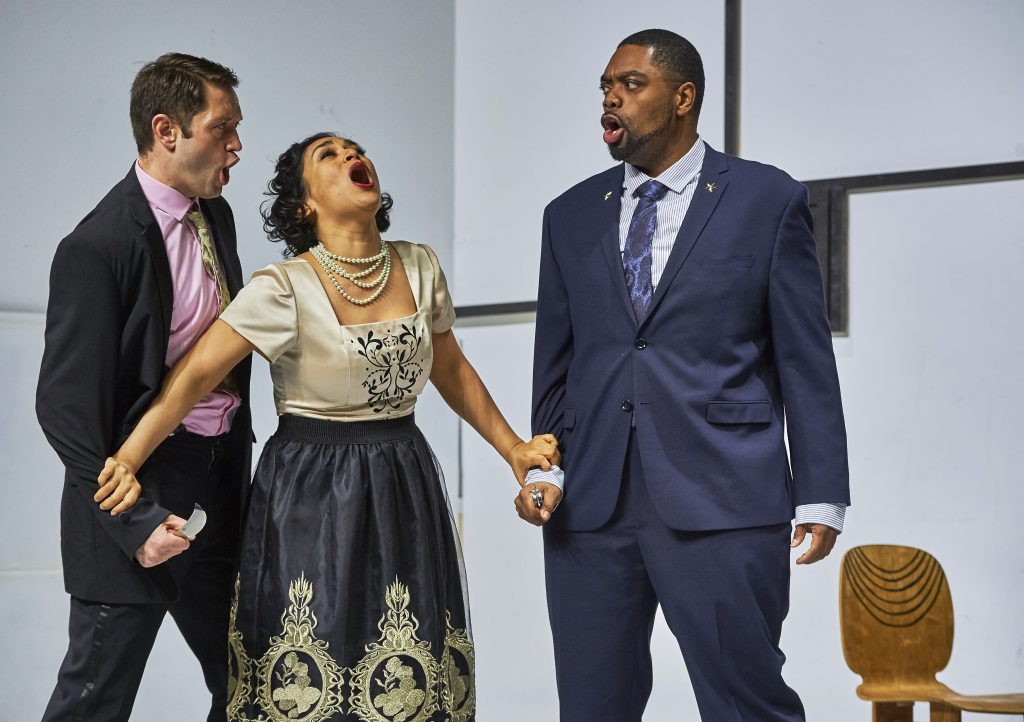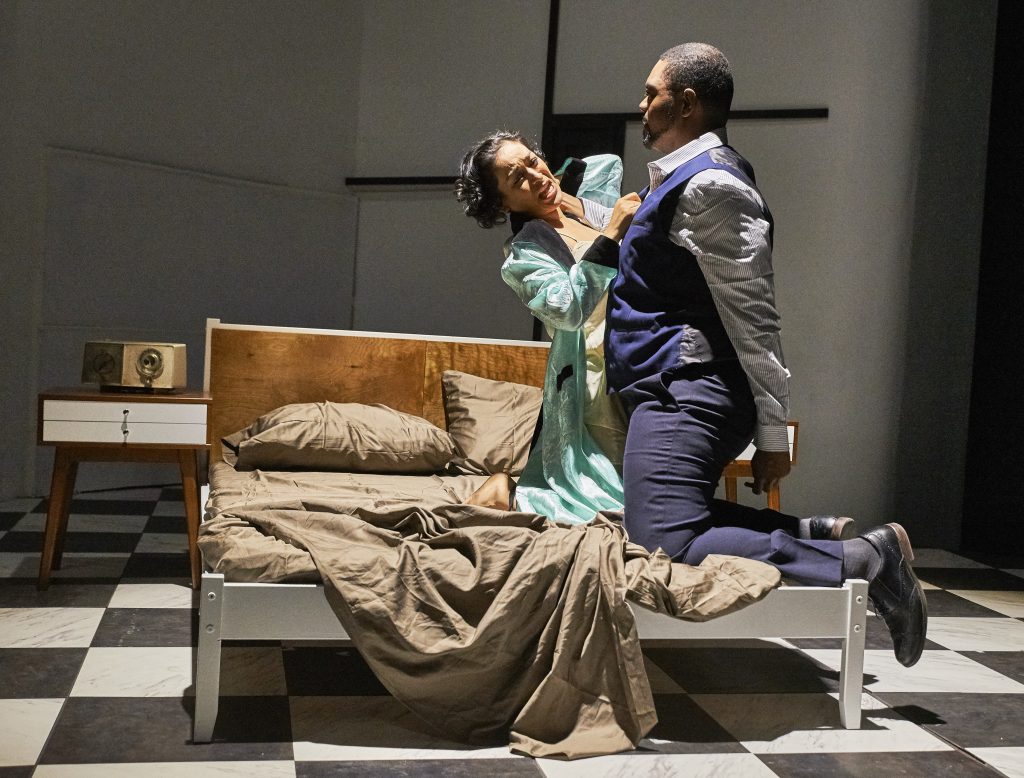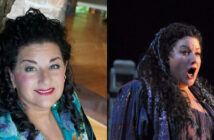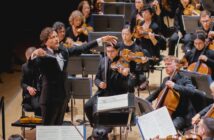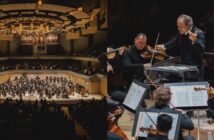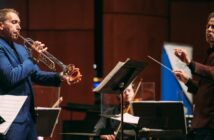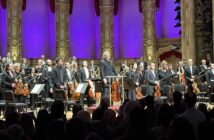REVIEW: LoftOpera’s new production of Rossini’s Otello;
INTERVIEWS: with maestro Sean Kelly, director John de los Santos, and soprano Cecilia Violetta López.
They’ve Done It Again
Scrappy, iconoclastic, resourceful, and unaffectedly hip, the LoftOpera company has been doing its own thing since 2013, demonstrating time and again – and with streetwise savvy – how an opera grows in Brooklyn. No rarefied proscenium-framed hothouse required. Just outer-borough grit, plus equal parts determination and talent. Then watch what springs up in a loft on the Gowanus Canal or a repurposed Navy Yard garage; a former brass foundry, a derelict warehouse, or a Bushwick circus school.
LoftOpera knows how to bring it.
And they’ve brought it again, with their new production of Gioachino Rossini’s long-overlooked Otello (1816), in six performances through March 27 at Brooklyn’s LightSpace Studios (viewed here at the opening on March 16) .
All Aboard! All A-Loft…
As usual with LoftOpera productions, getting there is part of the fun.
Disembarking from the L train at Brooklyn’s Jefferson Avenue stop, you begin to feel the exhilaration. Lofties seem somehow to self-identify, and recognize each other – an underground “League of Extraordinary Aesthetes.” Coalescing into a mini-throng at street level, you move en masse, pace quickening, skimming nimbly over slicks of black ice on Wyckoff Avenue and Thames Street, and finally glimpse the big midway-style carnival sign on the sidewalk up ahead. “OPERA” marks the spot.
Belly Up
Starting an hour ahead of curtain time, liquid bonhomie flows readily. The large space is encircled by banked white cyclorama walls (LightSpace is a popular photo and film shoot studio by day). A tall, pleasant fellow near the door, swigging a beer, suggests you “check in with the girl with pink hair.” There she is, easily sighted in the teeming room as she darts amidst the rows of folding chairs. She hands you your program and points you toward the bar. Brooklyn Lagers, plus assorted varietals of “Archer Roose” wine (an up-and-coming deluxe-in-a-box commodity) are being vended at five dollars a pop.
Chatter mingles with the mounting cacophony of instruments tuning up. Eventually, a guy and girl mount the stage. Hubbub subsides and everyone takes seats. The girl has an irresistibly sunny smile; and you recognize the guy as the tall, pleasant fellow with the beer (he’s jauntily swigging another one). They prove to be Brianna Maury and Daniel Ellis-Ferris, two of the company’s three founders (along with Dean Buck). They also happen to be brother and sister.
“It’s been 40 years since anyone’s done Rossini’s Otello in New York,” Maury announces to applause.
“And it’s not Verdi,” Ellis-Ferris adds emphatically. “In fact, use that hashtag! ‘#NotVerdi’!”
And So It Begins…
Even before a note of Rossini’s is sounded, one can’t help noticing, and (at least if one is at all familiar with the Shakespeare or Verdi versions of the tale) musing luridly about that big bed dominating the playing area. Does Rossini actually tell his Otello in bloody flashback?
No, as it turns out. Yet that bed – one of director John de los Santos’ many canny, economical touches – nonetheless works as a circular-structure prompt. Much like a melodic phrase you know must ultimately resolve, the image of the bed powerfully prefigures the opera’s dark climax, and functions like a suspended preparation to an eventual great falling cadence.
A Time of Miracles
“I don’t like to reset things for the sake of it,” says director de los Santos. “But we knew we couldn’t afford to do the opera in full Renaissance costumes. So I tried to think of a 20th-century environment that would be right, and the period of the [post-WWII Italian] ‘Economic Miracle’ jumped out at me.”
Specifically, de los Santos says, the year 1957 – a time with apt parallels to many of the political and social themes swirling in the background of the opera.
“The Treaty of Rome had just been signed,” de los Santos explains. “Italy had joined NATO; it was trying to become part of a global community, and flush out the [remnants]of nationalism and fascism. It was a time when an African general might have come to prominence.” Yet tensions also abounded, and shallowly concealed social instabilities were fissured with veins of mistrust – of government, and of one’s neighbors. The director’s inspiration is a richly rewarding one.
The Other Guys
While Verdi, in his much later 1887 Otello, followed Shakespeare’s plot more closely, emphasizing the dark voyage into Otello’s molten psyche, Rossini and librettist Francesco Maria Berio di Salsi opted instead to titivate the narrative with flashy external elements. They also shuffled characters, rewrote relationships and shifted locales. The formerly minor figure of Rodrigo becomes the Doge’s son – intent on winning Desdemona and, thus, becoming Otello’s principal rival. Iago is no longer a lowly ensign, but a crafty and connected power player with a hand in several illicit plots. The action, confined mostly to the provincial outland of Cyprus for Verdi, unfolds for Rossini entirely within the brittle and dangerous political stratosphere of Venice (fancifully referred to as “Adria” in the libretto). Racial animus is also more explicitly implicated in Rossini’s opera than in either Shakespeare or Verdi: Otello is lauded for his service to the state, but furtively reviled as a “filthy African.”
And while a pilfered handkerchief is of looming consequence in Shakespeare and Verdi, Rossini’s Otello turns on the complex mechanics of an intercepted letter (though de los Santos finds ingenious ways of reintroducing the optic trope of the handkerchief here, again leveraging the familiar to clarify the new).
Finally, and most notably, the role of Desdemona is far more fully developed here than in either of the other two versions. Indeed, she is arguably the de facto central character for Rossini, suffering not only the loss of Otello’s faith in her, but an excruciating public humiliation at the hands of her tyrannical father – traumas portrayed as so dire as to trigger a tumultuous mad scene, fully as flamboyant as that in the later Lucia di Lammermoor (and performed here with hair-raising brio by brilliant soprano Cecilia Violetta López).
Whose Wife is She Anyway?
“You need a director to give you the green light,” López says of the mad scene; she gets that green light from de los Santos, and she pushes pedal to the metal.
Rossini entertained the notion of calling the opera Desdemona. One can see why. Perhaps The Passion of Desdemona might be even more appropriate.
In short, bouncing off from Shakespeare, Rossini and his librettist crafted something new – an expert, laminate, glinting melodrama dense with strata of lust, power, racism, and insanity. One may rightly treasure the measured and inexorable tracking of the hero’s moral corruption in the original tragedy or Verdi’s 1887 opera – the long burn of the dramatic fuse, the psychologically supercharged cat-and-mouse intrigue – but no one can quibble with or gainsay the sheer audacity, theatricality, and verve of Rossini’s shaggy-dog tale of the Moor and his missus.
The Shape of Things
Director de los Santos’ shaping and staging of the story are exemplary, chockful of effective details and successful conceits. The opera’s opening chorus, praising Otello’s military conquests, becomes a radio transmission tensely audited by Desdemona, her father and her friend, Emilia. The chummy old-boys’-club reception for General Otello has a vintage, smoke-filled-room savor to it, as senators and the Doge assemble for a loopy, pre-Mad-Men-era stag party.
Later, when Iago peremptorily rebuffs two “hostesses” so that he can be alone with Rodrigo – ostensibly to plot Otello’s downfall – de los Santos mines a lush tenor duet for all its ambiguous suggestiveness.
“The first time they [Iago and Rodrigo] sing together in unison,” observes de los Santos, “it’s a beautiful and sensual line: ‘If once we were united in times of strife, let us be united again to help us through this.’” Iago may be a political subversive (cast as a square-jawed blond with the deportment of a martinet, he is plausibly re-figured in de los Santos’ update as un cripto-fascista mole); but he also seems to entertain certain other, possibly intimate, aims.
Throughout the production, de los Santos interpolates well-calculated dumb-shows and bits of unscripted business to enhance orchestral passages or amplify the plot: an opening enactment of Otello’s and Desdemona’s “secret marriage” vows; a sinister murder fantasy, played out with the Doge’s desk as sacrificial altar; a slow-motion version of a fateful knife fight, ending in a cliffhanger stage-freeze (since the fight’s outcome is not made explicit until the opera’s final moments).
To initiate Act II, de los Santos innovates a pantomime of gossipy aristocrats seated amidst a profusion of potted plants, spying on their peers – a sort of Adriatic “Ascot Gavotte” which then evolves into a taut and telling musical-chairs pas de trois for Rodrigo, Otello and Desdemona. Iago looks on inscrutably; the Green-Eyed Monster is clearly muse.
The sequence culminates with a satisfying feint of gumption from Desdemona, as she addresses a crisp and resounding slap to Iago’s face.
And when the action of Rossini’s opera returns at last to that bed, intersecting finally with the known contours of Shakespeare’s story, de los Santos whips up gasp-inducing intensity for his climax, staged amidst harrowing dashes of lightning.
The Sound and the Fury
Rossini’s score for Otello boasts in spades the features we expect of any Rossini offering, and then some. Here are all the master’s fierce and unremitting musical energy and drive, along with an expressive variety and tunefulness that seem impossible to account for but by witchcraft. How does he turn mere gestures of arpeggio to such multiform effect?
There are also orchestral colors and contrasts that almost defy the modesty of their means – one seems to hear proto-romantic sounds that should by rights be precluded in this pre-Berlioz aural universe.
“It was the first complete opera he [Rossini] wrote for Naples,” explains LoftOpera music director, and the conductor of Otello, maestro Sean Kelly. “Rossini found himself in front of some of the best musicians in the peninsula at the time.”
And he certainly rallied to the occasion.
Moreover, there are astonishing anticipations here of some of Verdi’s most memorable later “inventions.” Verdi’s 1887 “Sì, pel ciel” duet for Iago and Otello, for instance, can actually be heard ghosting lustily here in the earlier, apposite Rossini number.
“Verdi shamelessly stole a lot of it!” maestro Kelly concurs. “It was a very influential piece.”
Kelly conducts LoftOpera’s Otello with masterful insight, eliciting both amplitude and subtlety from his principals, his excellent and sizable instrumental ensemble, and his polished chorus.
Places, Please!
The sung performances were all commendable – a heartening indication, one might hope, of the deep bench of ready talent available for more such Loft-style grassroots opera outings.
But first, let’s talk tenors. Rossini, of course, was among the earliest opera composers to valorize the tenor voice consistently as the stuff of leading roles and star turns. But, practical man of the theater that he was, he also wrote for what was available. What a squad, then, Naples must have fielded him for this veritable tenor-fest of an Otello.
In the LoftOpera production, John Ramseyer’s lovely, lyrical tones are deployed in dual roles – first, for the rather functional character of the aide, Lucio; then, notably, as the mesmerizing offstage Gondolier of Act III, whose haunting “Nessun maggior dolore” is rendered with pure and eerie crepuscular elegance.
Tenor Lucas Levy is excellent as the Doge. His voice is suave and dark, and he evokes to perfection the easy urbanity and glib glad-handing of the career politician.
Tenor Thor Arbjornsson, as the hotheaded and luckless Rodrigo, negotiates the opera’s most aureate male vocal lines with clarity and aplomb, while his lanky agility, cocksure sneer, and boyish ardor all contribute to a keen portrait of the young naïf as villain’s dupe and hero’s foil.
Tenor Blake Friedman makes of Iago a creature of compellingly watchable contrasts – at times bewitching in catlike stillness; at others striking out with bright vocal brashness, or seducing with tones of purple-chocolate succulence. Compact of build, sleek and nimble, a treacherously handsome crocodile-dandy in black velvet blazer and rainbow cravat – it’s a delightfully wicked and memorable character creation.
Tenor Bernard Holcomb, as Otello, brings a suitably noble bearing, restrained intensity and brooding chivalry to the role. His voice is rich, natural, and lithe, and caresses the role’s high tessitura with virtuosic ease (Holcomb even interpolates one high E).
The opera’s single lower-voiced principal role – Desdemona’s father, Elmiro – is limned vigorously by bass-baritone Isaiah Musik-Ayala, offering authoritative recitatives and commanding ensemble work of fine and indispensable sonority.
As for the women, there’s mezzo-soprano Toby Newman as Desdemona’s friend and comforter, Emilia, exuding commonsense and earthiness. Accessorized by cat’s-eye glasses and a take-no-prisoners attitude, Newman also offers a soupcon of mordant humor via glances of distaste or worldly-wise grimaces, all of it supported by admirably warm mezzo tones.
Finally, soprano Cecilia Violetta López, as the doomed Desdemona, brings lustrous emotional honesty and constantly shifting nuance to this fully dimensional lady of passion and perils. Every vocal figure – from the simplest recitative to the most ornate fioritura – arrives like the inevitable emanation of some organic impulse. Rarely does one witness an opera performance so intimately imagined, so minutely observed, delivered with such thorough transcendence of technical concerns, so fearless, so fully alive.
Yet, amazingly: “This is my first Rossini role,” López confides.
It cannot be her last.
A Far Land
Not unlike Tancredi and others of Rossini’s “tragic” operas, the composer was compelled by public taste to fashion an alternative, now rarely performed “happy” ending for Otello. But, in a way, traditional genre distinctions may be the least illuminating way of codifying the Rossini canon. Given the latter-day Rossini “renaissance” that has flowered for well over half a century now, it seems time to avow him a composer without borders, his flag staked boldly and unrivaled in a strange aesthetic land all his own. It’s a place where the devil capers like a deft jester, and love or death may issue equally and unpredictably to the same cascades of glorious melody.
While many another composer before and since have been drawn to Shakespeare for inspiration, Rossini may actually be the most profoundly Jacobean in sensibility. His Otello seems conceived not at all in homage or deference (as Verdi’s was), but in the spirit of a virtual contemporary, doing a rewrite.
One can but dream of a Rossini who might have applied his mercurial, Janus-faced brilliance to some even more daemonic-humored dramatist, like John Webster. Imagine a Rossini Duchess of Malfi, or a Rossini White Devil.
It’s the stuff of covetous sighs; and terrified shivers.
LoftOpera’s Otello is being performed at LightSpace Studios, 1115 Flushing Avenue, Brooklyn, New York. Tickets, while available, can be purchased here. The remainder of LoftOpera’s upcoming 2017 offerings (in a roster slightly revised from that previously announced) are: a narrative staging of Giovanni Battista Pergolesi’s Stabat Mater, plus selections from Vivaldi, in June; Ruggero Leoncavallo’s Pagliacci in September; and Béla Bartók’s Bluebeard’s Castle in December 2017. Locations vary. More information is available here.



